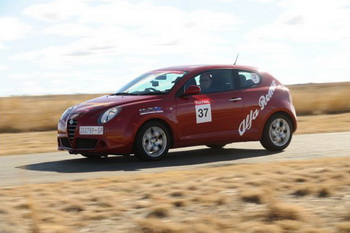
 |
|
Geoff Mortimer and his co-driver, Gerry
Gericke, piloting the #33 Alfa Romeo MiTo
1.4 Progression, returned a very impressive
fuel consumption of just 6.25 l/100km during
the 35th edition of the South Africa's
prestigious Total Economy Run. |
|
|
|

 |
|
A second Alfa
Romeo MiTo took part in the Total Economy
Run, which was held in and around Thaba ‘Nchu in
the Free State last weekend, this example, the #37 entry,
was in the hands of Elza Thiart and
Theonette Vogt. |
|
|
|
The MiTo is conclusive
proof that Alfa Romeo is not just synonymous with the
colour red, it’s also bright green. Geoff Mortimer and
his co-driver, Gerry Gericke, piloting an Alfa Romeo
MiTo 1.4 Progression, returned an impressive fuel
consumption of just 6.25 l/100km in the 35th edition of
the South African Total Economy Run which was
held in and around Thaba ‘Nchu in the Free State this
past weekend.
Danie Human, who oversaw Team Mortimer, said: “I am very
pleased with the result. We might only have achieved a
sixth place in our category but it’s worth noting that
we were placed in Class B for cars between 1100 and
1400cc – the average output for vehicles we were
competing against was half that of the MiTo’s 100kW. Had
the competition classified vehicles on the basis of
power, the Alfa would have been in Class E with
2.0-litre competitors and we would certainly have palmed
in a class win. I have no doubt that with more and more
manufacturers going the downsising route, Total will
create a new category for smaller turbocharged
vehicles.”
Alfa Romeo achieved this result thanks to the MultiAir
technology in the MiTo working in conjunction with
Start&Stop. The new Euro 5-ready 1.4-litre MultiAir
engine, developed and patented by FPT (Fiat Powertrain),
is initially offered in two turbocharged petrol forms
for the South African market. The 100 kW version of the
unit powers the MiTo 1.4 Progression, while the racier
125 kW 1.4 unit powers the MiTo Quadrifoglio Verde
flagship as well as Alfa’s new jewel in the crown, the
all-new Giulietta (in this instance, the
middle-of-the-range Distinctive model).
In addition to MultiAir, the MiTo and Giulietta ranges
showcase a broad spectrum of innovative technologies,
including, the emission-reducing Start&Stop system
(switches off the engine when idling), and Alfa Romeo’s
highly acclaimed DNA system. With reference to the
latter, it’s derived from Alfa’s racing roots and allows
drivers to choose between three driving modes (normal
for eco-driving, all-weather and dynamic for when you’re
in a heavy-footed mood) by communicating with the
engine, brakes, steering and transmission.
MultiAir
This technology does exactly what it says on the box: it
takes precise control of the quantity and
characteristics of the air drawn into the cylinders in
the combustion cycle. Bear in mind that there are
numerous electro-mechanical variable valve timing
systems in production today that seek to achieve this,
but because they have no more than two operating
regimes, they are severely limited by the degree of
flexibility they can exercise in the valve opening
schedules.
By contrast, MultiAir completely eliminates these
compromises by metering the direct air charge at the
cylinder inlet ports with an advanced electro-hydraulic
actuation and control system that has no fewer than five
basic parameters, and the ability to optimally adjust
valve timing and lift between them to exactly suit
different engine speeds and loads, ensuring strong low-
and mid-range torque and vigorous top-end power,
combined with good economy and low emissions.
This is a transformational technology comparable to the
introduction of FPT’s common rail fueling for diesels
(another first for the Fiat Group a few years back), but
the principles behind it are as simple as they are
ingenious. MultiAir engines have just one camshaft with
three lobes allocated to each cylinder. The first two
control the two exhaust valves in the conventional way,
while the third defines the maximum possible lift and
opening duration of the two inlet valves. It also acts
on a small piston that sends engine oil, via pressurised
hydraulic channels, to additional pistons located just
above the inlet valves.
Four solenoid valves - one for each cylinder under
individual control from the Magneti Marelli ECU engine
management system - can be opened at any point during
the inlet valve's movement to bleed off the oil. Varying
the oil flow instantly and precisely controls the
opening and closing of the valves between the parameter
extremes mechanically described by the camshaft lobe for
optimum results. MultiAir can even open the inlet valve
twice in one intake stroke, when running at low speeds
and loads around town, to create more swirl of the
intake mixture, enabling it to burn more completely,
thereby lowering fuel consumption.
|
|
|